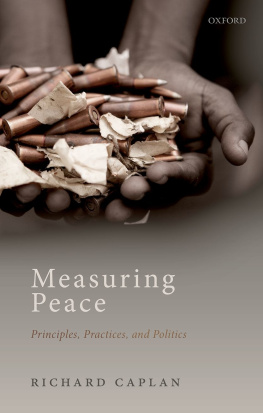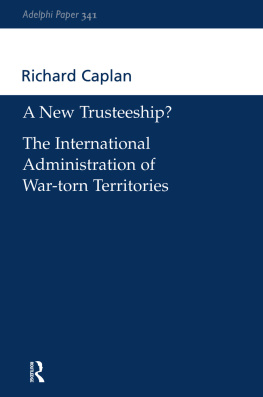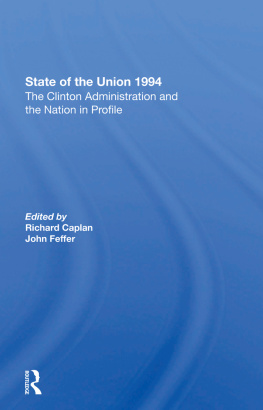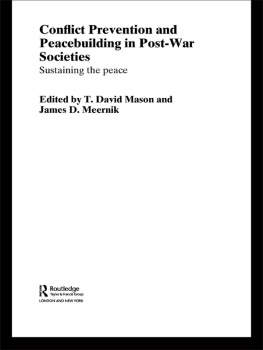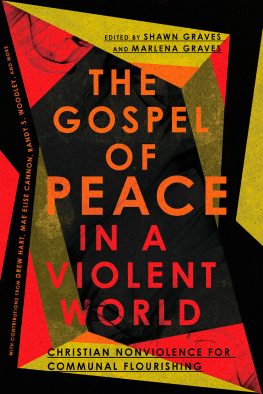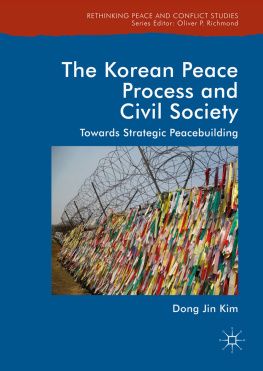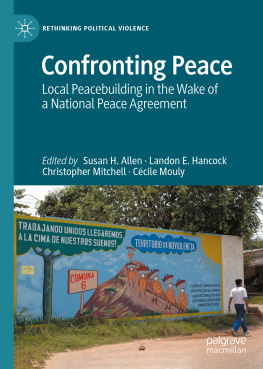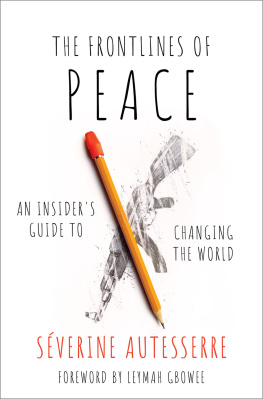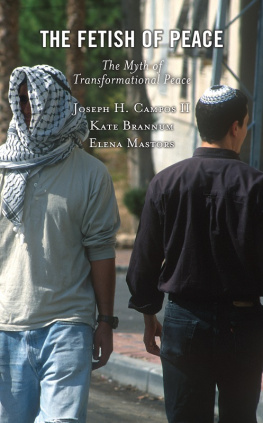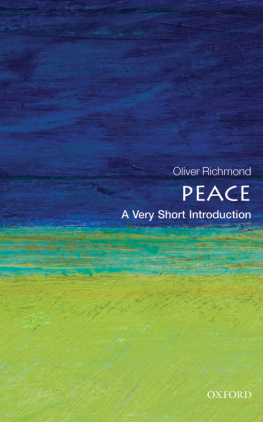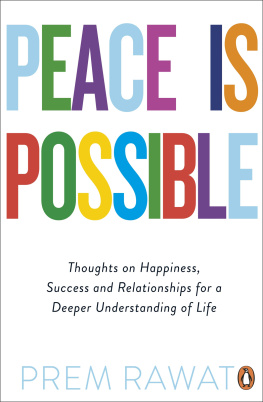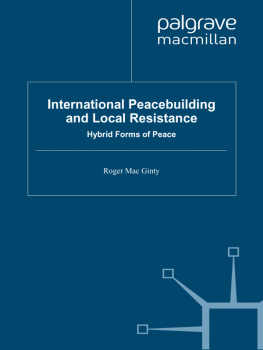Measuring Peace

Great Clarendon Street, Oxford, OX2 6DP, United Kingdom
Oxford University Press is a department of the University of Oxford. It furthers the Universitys objective of excellence in research, scholarship, and education by publishing worldwide. Oxford is a registered trade mark of Oxford University Press in the UK and in certain other countries
Richard Caplan 2019
The moral rights of the author have been asserted
First Edition published in 2019
Impression: 1
All rights reserved. No part of this publication may be reproduced, stored in a retrieval system, or transmitted, in any form or by any means, without the prior permission in writing of Oxford University Press, or as expressly permitted by law, by licence or under terms agreed with the appropriate reprographics rights organization. Enquiries concerning reproduction outside the scope of the above should be sent to the Rights Department, Oxford University Press, at the address above
You must not circulate this work in any other form and you must impose this same condition on any acquirer
Published in the United States of America by Oxford University Press
198 Madison Avenue, New York, NY 10016, United States of America
British Library Cataloguing in Publication Data
Data available
Library of Congress Control Number: 2018968139
ISBN 9780198810360
ebook ISBN 9780192538345
Printed and bound in Great Britain by Clays Ltd, Elcograf S.p.A.
Links to third party websites are provided by Oxford in good faith and for information only. Oxford disclaims any responsibility for the materials contained in any third party website referenced in this work.
For Daniel
Acknowledgements
This book has been (too) long in the making, and I am very grateful to many individuals and institutions for their valuable input and support along the way.
I owe a very large debt of gratitude to the Folke Bernadotte Academy, which took a keen interest in this project from its inception and made significant contributions to it, intellectual as well as financial, from beginning to end. The Folke Bernadotte Academys commitment to scholarly research in the fields of peace- and state-building is truly impressive.
Without the benefit of a British Academy fellowship, I would never have found the time to undertake the initial research that started the ball rolling. I am grateful to the Academy for taking a gamble on me.
The UK Department for International Development was very generous in supporting the research that underpins of this book. They also took an active interest in the research itself and made very valuable contributions to it.
Many of the ideas for this project originated with a consultancy I did for the United Nations (UN) Peacebuilding Support Office (PBSO) a number of years ago on measuring peace consolidation and managing transitions, which led to the production of an internal briefing paper that I had the honour to present to the UN Peacebuilding Commission. I was pleased that one of my recommendationsfor the production of a benchmarking handbookwas taken up by the PBSO, resulting in the publication of Monitoring Peace Consolidation: United Nations Practitioners Guide to Benchmarking, expertly written by Sven Erik Stave of Fafo. It has been exciting to see greater and more effective use of benchmarking as an instrument of assessment throughout the UN system, as I discuss in .
The ideas that emerged from my work with PBSO were explored further in the context of two conferences I organized that brought together scholars and practitioners at Wilton Park, the global forum based at Wiston House in the bucolic British countryside of West Sussex. The first conference, on exit strategies and peace consolidation in state-building operations, was held on 1315 March 2009. The second conference, on measuring peace consolidation, was held on 1517 October 2014. Both conferences allowed for an unfettered exchange of ideas and experiences. I am grateful to Wilton Park and its programme director Isobelle Jaques, in particular, for their assistance in organizing the conferences. Financial support was provided by the Centre for International Studies, University of Oxford; the Fafo Institute for Applied International Studies; the Norwegian Peacebuilding Resource Centre; the Folke Bernadotte Academy; the Swiss Federal Department of Foreign Affairs; the British Academy; the Organization for Security and Co-operation in Europe, Vienna; and the Public Diplomacy Division, North Atlantic Treaty Organization, Brussels. I am grateful to all of them for their generous assistance.
I am also grateful to Linacre College Oxford for the grant I received from the Lucy Halsall Fund in support of my overseas research expenses.
For their very valuable research assistance, I am grateful to Nicholas Barker, Kate Brooks, and Allard Duursma.
A number of individuals read all or parts of this manuscript and I am extremely grateful to them for their input: Nicholas Barker, Alex Bellamy, Jane Boulden, Frances Brown, John Gledhill, Anke Hoeffler, Lucas Kello, Lara Olson, Michael von der Schulenburg, and Remco Zwetsloot. I have also benefitted from the feedback I received from presentations to the Oxford International Relations Colloquium and the Oxford University Strategic Studies Group, and from conversations with many of my Oxford colleagues.
A version of the Introduction to this book appeared as Measuring Peace Consolidation in the British Academys Rethinking State Fragility (London: British Academy, 2015). I am grateful to the British Academy for granting me permission to use this material.
, co-written with Anke Hoeffler, appeared in modified form in the European Journal of International Security (Vol. 2, No. 2, July 2017). We are grateful to Cambridge University Press for granting us permission to adapt this article for inclusion in this volume. We are also grateful to Lise Howard for the use of her UN peacekeeping operations data and to Kate Roll for updating it. Chris Perry gave very helpful advice on the use of the International Peace Institute data on UN peacekeeping. Joakim Kreutz clarified the use of the UCDP conflict termination data. The FHI 360 Education Policy and Data Center provided data on horizontal inequality. Daniel Gutknecht, Ron Smith, Mns Sderbom, the six case study authors, and the participants in the project meeting in Oxford on 6 February 2015 all provided useful comments and suggestions.
Dominic Byatt at Oxford University Press has been as patient and encouraging an editor as one could ever hope to have. I am grateful for his support of this and earlier projects of mine. Olivia Wells provided superb editorial assistance.
Finally, I thank my wife Luisa, for her forbearance especially, and my son Daniel, to whom this book is dedicated. May he and his generation know more peaceful times.
Contents
Factors of Post-Conflict Peace Stabilization
With Anke Hoeffler
African Centre for the Constructive Resolution of Disputes
Armed Conflict Dataset
African Union
United Nations Office in Burundi
Central African Republic
Correlates of War
disarmament, demobilization, and reintegration
Department of Political Affairs
Department of Peacekeeping Operations
Democratic Republic of Congo
Economic Community of West African States

